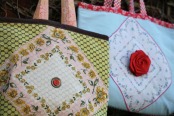If you’re like me, you cringe a bit when trying to do a hard sell on something—whether you’re trying to sell an idea to an editor or your wares at a craft show. It looks so easy on TV though, right? So on that note, I thought I’d reflect a bit on the sales lessons to be learned from some of my favorite TV shows. (Truthfully, the whole post could be just Michael Scott lessons, but I’ll just pick my favorite lesson from him.)
Strategy #1: The wine and dine approach. Order drinks and Awesome Blossoms, tell really bad jokes, and hang out at Chili’s all night. Only when you have thoroughly chatted your client up and made various personal connections should you go in for the sale.
Actual lesson: Michael Scott knows that you can’t go in for the hard sell right away. Building up a relationship with people first is a much better long-term strategy. If you remember, it’s Michael who gets the guy’s business, not Jan, who keeps trying to go for the hard sell from the first minute the meeting starts. I’m not sure where the making-out in the parking lot fits in, but let’s just set that aside for now.
Strategy #2: When client tries to convince you to take less money for something they desperately need you to do, slowly peel an orange and calmly say, “What’cha wanna do?”
The lesson: This is now one of my top five favorite 30 Rock moments! What Alec Baldwin’s character realizes is that the nanny has true leverage, and when you have true leverage, you don’t have to say very much at all.
Strategy #3: Never be the first to throw out a number. Rick on Pawn Stars has this down. He always asks the seller what they want for their wares. Always. (I’ve never seen him throw out the first number.)
The lesson: I’ve heard that in negotiating, the person who speaks first automatically loses power. I think there might also be an Office episode about this? It sort of makes sense. But I am far too much of a nervous Nelly gap-filler to make the silence strategy work for me!
Strategy #4: The power of three: House Hunters always shows home buyers three houses, and inevitably it follows this formula (not always in this order): (1) total piece of crapola, (2) a place that is way out of their budget, (3) a place that is still taxing their budget, but less than the total budget-buster so it suddenly looks like an amazing bargain.
The lesson: Give buyers options, and always include an option that is most likely out of their reach, just to make the one you’re really trying to sell look like a bargain.
Strategy #5: Make fake phone calls to people and pretend that you’ve sold your entire stock of computers to beat your childhood nemesis and win the coveted water pick.
The lesson: George Costanza knows how to do two things really well: tell the perfect lie and fake it. And sometimes the faking it route can sort of come in handy—as in, fake it till you make it. Of course, I don’t mean actually falsifying your sales! Rather, faking confidence until you actually feel confident. It works for other stuff, so maybe it can work for selling too?
Strategy #6: Be so goopy and sincere and generally in love with the idea you’re selling (a la Leslie Knope selling The Harvest Festival to the town of Pawnee) that no one can possibly say no to you.
The lesson: The energy you put out there truly does matter! So maybe you want to dial it back a few clicks from Leslie Knope, but truly believing in what you are selling is still the number one strategy in my book (and the only one that doesn’t give me the skeevies).
So I tried to use Random Number Generator (I even got the widget) but then when I plugged in the numbers in my blog edit mode (and it gave me a number), I couldn't make that show up live. I obviously need to research more how to use it! Anyway, you'll just have to trust me that when I did it, it tossed out random # 144, which when I counted the 150 comments, that was Gail Goodhand. Congrats, Gail! I have your email and will be contacting you shortly about getting you the book, and having the folks at Spoonflower work with you on fabric.
Thanks everyone for entering! Please keep checking back for more giveaways.
A few months ago, I did this little article for ElleDecor.com about Spoonflower. I’d never used Spoonflower before, but had heard the buzz about it and wanted to find out more (it’s pretty cool to have a job where you get paid to learn about various random things that interest you). I talked to co-founder Stephen Fraser about the North Carolina start-up, watched this short video and was very intrigued by this novel print-on-demand fabric venture that he and business partner Gart Davis started in 2008 (with much help from their wives, Kim and Anne). 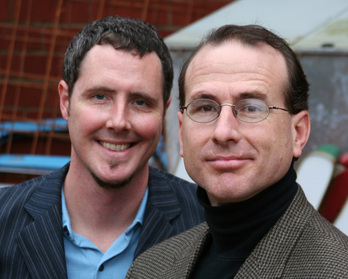 Spoonflower founders Stephen Fraser and Gart Davis. Photo courtesy Spoonflower. They went from cutting fabric at their kitchen table to a community of 100,000 users in under three years—entirely by word of mouth. After I wrote the ElleDecor.com piece, I realized that Stephen would be a great person to do a Q&A/giveaway with, and he very generously agreed. 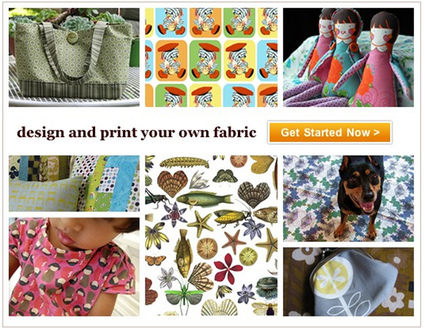 The Spoonflower home page. Photo courtesy Spoonflower. 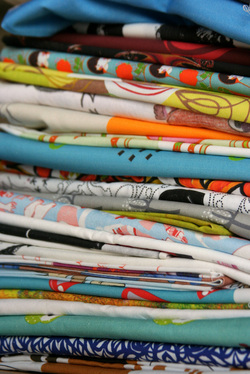 Photo courtesy Spoonflower. So, in addition to a signed copy of Sew Retro, the winner of the giveaway will also get two yards (a 2-yard cut of one print, or two 1-yard cuts of two different prints) of Spoonflower fabric-- either your own design or someone else’s. This is your chance to try your hand at designing your own fabric, or to buy someone else’s custom-designed creation. Sounds like a pretty sweet deal to me!
To enter, leave a comment about Spoonflower—perhaps your favorite Spoonflower print or a suggestion for their next design contest—by Wednesday, February 23nd, 2011, at noon EST.And now, here is the Q&A with Stephen Fraser, with a little help from his wife, Kim. Enjoy!
Q: So, you are up to 100,000 strong in the Spoonflower community, and the site is positively brimming with talent from all over the world. Could you ever have envisioned this three years ago? What were your original goals for Spoonflower?
Fraser: Spoonflower came about because of a conversation I had one night with my wife, Kim, who wondered why she couldn't get her own fabric design printed to make curtains. Being an Internet guy, I found it strange that there wasn't already service that allowed people to create their own textiles, so I approached a friend, Gart Davis, about the idea and we ended up launching the first version of the Spoonflower site around May of 2008.
The Spoonflower community has grown to well over a 100,000 people at this point, which is a huge thrill for us. We keep a map on the wall—printed on fabric of course—with pins in it showing all 114 countries to which we've shipped fabric so far. When we got started we were hopeful, of course, that the idea of custom printed fabric would catch on, but from a personal standpoint it's a bit dizzying to look at where we are now compared with where we started. Building a manufacturing business from scratch using our own limited funds has been a learning experience full of challenges at every turn.
The goal with which we started was relatively simple. We wanted to take digital textile printing technology—which made it possible to print fabric with no minimum—and to make it accessible to regular people. By "regular people" I mean crafters—people like my wife Kim—who have a passion for fabric and making things but who would never spend $50 a yard to use a specialty printing service for custom fabric. To make that possible we had to solve two central problems. The first was to figure out a way to produce digitally printed fabric quickly and relatively inexpensively. The second challenge was to develop a web-based process for creating and ordering fabric with your own design that was simple and easy to use. So that's what my business partner Gart Davis and I set out to do when we started. We had a head start on the second challenge because we'd both worked for an Internet business that offered print on demand products before (Lulu.com), but we really had a lot to learn about textiles and handling digital printers. But in terms of learning the trade, we had the good fortune to live in an area with a lot of expertise not only in textiles, but also in digitally printed textiles specifically. The NC State College of Textiles is nearby, and so is a not-for-profit organization called [TC]2, which serves the sewn goods industry. They were extremely helpful to us as we went about learning what we needed to know to develop Spoonflower.
Q: Where did the name Spoonflower come from? Fraser: Spoonflower is the common name of an endangered wildflower that is native to the Southeast and grows on the edges of swamps and bogs. Kim and I ran across the name several years ago when we were figuring out what kinds of plants we could use in the rain garden in our backyard. We thought it would be the perfect name for a business that was all about self-expression and individuality.
Q: The Spoonflower story sort of reminds me of the story of Butterick patterns. One night, Ebenezer Butterick’s wife mentioned that it would be great to have sewing patterns that were already graded (sized). Butterick, a tailor by trade, saw the light bulb and started Butterick patterns! How long was it from the time you had this conversation with Kim until Spoonflower launched, and what did you do to plant the seeds for your business?
Fraser: The conversation about Kim's curtains happened in the fall of 2007, when Kim was pregnant with our third daughter, who was born that December. I think Gart and I sat down for coffee in early January 2008 and decided to pursue the idea of a print on demand fabric business. We started by asking crafters what they thought of the idea and posting a short survey online, which was then picked up and linked by several crafting blogs, including Sew Mama Sew. Within a few days we had over 500 responses to the survey. What was clear to Gart and I immediately was that our wives were not the only ones excited about the idea of printing custom fabric—lots of people wanted us to create this service.
First we set up a blog to record our progress and then we went about the process of starting to build the software that would allow Spoonflower to exist. The buzz about Spoonflower spread from blog to blog through the spring and summer and by the time we opened up the site to one and all in October of 2008 we had thousands of people—not just signed up to use Spoonflower—but cheering us on.
Q: You mentioned that you had previously worked for Lulu.com, where you gained experience in print-on-demand. What was the learning curve like when you started working with printing fabric?
Fraser: Helping develop Lulu taught us a lot about giving people the power to publish their own creations online. We understood the landscape in the sense that we knew that our task was to provide tools that enable a creative community to accomplish various things associated with the central task of creating custom fabric. We knew that we always had to give people control over their own work, how to manage and nurture a community of people who want to share their creativity with one another, and how to encourage people to connect with others and discover new designs.
Having said that, the Spoonflower experience has been wildly different from Lulu in terms of the resources available to us. Lulu was a technology company that from the beginning had significant financial backing, whereas Spoonflower was a startup founded by two guys without a lot of money. Where Lulu had a team of software engineers, we had one (Gart). But the part we really had to learn from scratch was the fabric printing. The story of our efforts master digital textile printing would take a long time to relate, but suffice to say it has required a lot of persistence. What kept us going even though the dark days when we thought we'd go bankrupt before we had it figured out was the enthusiasm of the Spoonflower community—customers who were so passionate and excited to have the chance to create their own fabrics and who desperately wanted us to succeed. When we started out, Kim had to explain to me the difference between linen and cotton. I'm slightly more educated than that now.
Q: So, does being around all of this fabulous fabric all day make you want to sew?
Fraser: Yes! I am always imagining projects that would be perfect for digitally printed fabric, but am brought to an abrupt halt by my inability to sew. But that's probably for the best—my to-do list is pretty long and I stay behind as it is.
Q: A question for Kim: Stephen mentioned that you are part of a generation of women who has rediscovered domesticity and sewing (I think we’re the same generation—I’m 36, so I hope I’m not adding years on to you!). Can you talk about what this process of rediscovery has been like, and how technology has impacted it?
Kim Fraser: I'll be turning 40 this year so no offense taken! As far as rediscovering domesticity, I should say straight off that I've always been a huge homebody and have been interested in learning how to make the things that I need for as long as I can remember, from growing and canning my own food, cooking and baking, sewing my own clothes, and making items for my house. I only dabbled with sewing in college but got serious about it once I had children. I remember trying to shop for dresses for my very tall oldest daughter—age six at the time—and finding nothing in the stores that didn't just look cheap or much too old for her. I started sewing simple dresses for her out of fabric that I let her pick out. (A god-awful dress made from a large horse print springs to mind.) Then when I got pregnant with my second daughter, the nesting urge kicked in hard. That's when I started really sewing in earnest—quilts, baby bedding, stuffed toys, etc. I love making clothes for my girls, and I still get so much satisfaction out of feathering our "nest." It's much more gratifying than buying stuff off a shelf that has no soul and no personal meaning to us.
Technology I have mixed feelings about. On the one hand, it can be so inspiring to cruise around online looking at all the beautiful things that fellow sewists and crafters are making. I also have to admit that I've struggled with guilty feelings about my domestic bent and worried that such interests weren't terribly modern or enlightened. It's tremendously validating to know that there are literally thousands of other women out there who also share my interests. But on the other hand, the internet is a huge time suck! I often have to remind myself very sternly to shut the laptop and just make something already!
Q: Back to Stephen, where do you come up with all those wacky and wonderful contest themes?
Fraser: I usually come up with the contest themes late at night the evening before we send out our weekly contest email. We've now done well over a hundred contests, which means that I'm always looking for new ideas and often rely on suggestions from Spoonflower community members, Spoonflower staff, and Kim.
Q: What is the biggest challenge for Spoonflower right now?
Fraser: Our biggest challenge on any given day is typically managing the growth of our company using the limited resources we have. We have a small, very devoted and hard working team of people at Spoonflower who do an amazing amount to make our business run. And we're continuing to grow each month that goes by, which is very exciting—and never boring! We're looking forward to doing some new things this year, but the first task is always to make sure we can keep up with our core business, which is printing the fabric people order from us every day. Our next big announcement will involve a promotion we're doing with a major quilting fabric manufacturer, which I expect will generate a lot of excitement in the fabric-loving community.
There is one review of my book on Amazon that drives me absolutely batty (I’m still working on my thick skin, as I’ve blogged about before). I’m convinced the reader saw the word “feminism” on the first page and immediately shut down and missed the point of the book (or stopped reading altogether). She said it was too political. Too political?
My first thought was: oh, I’ll give you political, honey. But some recent conversations with people have made me realize that I’ve softened quite a bit. I am in such a different place right now compared to my 20s, when I was always fired up about something—and usually certain that my liberal humanist way of thinking was the only right way.
Like everyone else, I had a journey: I grew up Catholic, but long ago rejected it (and religion in general, if you want to know the truth). I never rejected the idea of values though, and am a huge believer in the golden rule, which I’ve simplified even more: don’t be a jackass—not because of some judgment day quid-pro-quo. Rather, just because you shouldn’t be a jackass. That’s all I need. It’s been my truth, and I’ve spent a lot of time (and editorials) fighting other people’s narrow-minded beliefs, railing on about hypocrisy and devising smart comebacks when they told me they were praying for my agnostic soul.
But as I’ve gotten older and met lots of interesting people who have beliefs quite different than my own, I’ve realized that it’s not about right and wrong or stupid and smart. It’s about knowing your truth, and accepting that other people get to have their own truths. After all, part of not being a jackass is not judging other people as stupid just because they believe in things you don’t. How well they live by those beliefs is their business, and likely very complicated. What I get now is that tolerance is pretty hollow if I simply spend all of my time accusing other people of not being tolerant, and never look inside myself.
Why in the world am I writing about religion? Here? (My niece is about to graduate from college and wants to work in PR and she just started a blog to become more fluent in the world of social media. I told her: just don’t write about religion! Way to break your own rule, Judi.)
So why here? Why now? Simple: I’m tackling the big taboo “R” because of knitting.
Stay with me, please.
Knitting is one of those things I’ve tried on and off that I can’t get into. The needles don’t feel right in my hands. I don’t get into a flow when I do it, and I’ve never been able to get motivated to stay with it. Now, people create beautiful, amazing, unbelievably inventive things with knitting, and I appreciate it and drool over it. I see that yarn gets other people through the day.
But when I tried to knit again recently, it crystallized for me: it’s just not my truth, and that is okay. I have other truths.
I’m happy that people have their knitting, and I want them to go create lovely things with it that make the world happier. If they try to legislate their "knitting" in public institutions, then we have a problem. But otherwise, it’s live and let knit for me.
So, yes, it’s metaphorical, but also it’s very, very real. Creativity can be transformative in so many ways, including forcing us to examine our own beliefs about things as disparate as religion, women’s history, and childrearing. I truly believe that I am a more tolerant person because of crafting. And I also have a bunch of super-cute bags and skirts, so it’s a win-win.
What do other people think about this? What unexpected soul-searching journeys has crafting led you on?
It was fun to be back on the FOX19 Morning Show! This time, I was making the Valentine's Day cards I blogged about earlier this week. Here is the video!
Want something different this year? Here are three quick ideas for Valentine’s Day cards!
#1: Stitched Felt Heart Card
This is a great project for young sewers because it only uses a basic running stitch. The color combinations are endless. It’s easy, but looks very impressive.
You need:
-- Piece of felt (craft felt or wool felt)
-- Embroidery floss, pearl cotton, or yarn with stands pulled apart and needle
-- One small scrap and one card-size piece of cardstock
-- Craft glue or double-stick tape
1. Download the heart template. Use either size (I used the smaller one in the example). Cut out one heart from felt.
2. Cut a square from one piece of cardstock. Center the heart in the middle. Pin, or use a dab of glue in the middle to keep it secured to the paper while you stitch.
3. Tie a knot in the end of your embroidery floss (I used all 6 strands together), pearl cotton, or single strand of yard. Start from behind, and take a basic running stitch all the way around the edge of the heart, through the paper. Tie another knot at the end.
4. Glue (or use double-stick tape) the square of cardstock to the front of your card.
5. Write a cheeky note inside, like “You always keep me in stitches!” #2: Blanket-stitched Heart PendantWho says your Valentine has to be a paper card? Try this felt heart pendant. Use paint to write your Valentine’s name, or embellish with gemstones (keep it age appropriate, and obviously, avoid using anything that curious little ones will pull off and put in their mouths). Attaching a piece of floss or yarn means you can leave it hanging somewhere fun where your Valentine can find it, like on the bathroom mirror, coffeepot, or backpack hook You need
-- Felt
-- Embroidery floss, pearl cotton, or yarn pulled apart to single strand
-- Embroidery needle
-- Paint and/or gemstones (optional)
1. Download heart template. I used the larger size for this.
2. Cut two hearts from felt (layer so you’re cutting them at the same time). Pin them together.
3. Tie a knot in your embroidery floss, pearl cotton, or yarn. Do a blanket stitch. Don’t know how to do it? It is EXTREMELY easy. Watch my short how-to video here. Tie a knot at the end.
4. Use the same or contrasting floss, pearl cotton, or yarn to make the loop for hanging. First, tie a knot in the end of the floss. Starting from behind at the top point of the heart, pull your needle through. Create a large loop by taking another stitch back through (from behind), and then anchoring it with one more stitch. Tie a knot and clip thread ends.
5. Embellish by painting name, attaching gemstones, etc. #3: Recycled Heart CardThis is the most involved of the three, but still not difficult. It just uses a very basic split stitch. It’s a great way to re-purpose an old shirt (this was a shirt of my husband’s). You need
--Heart template
-- Embroidery hoop
-- Scrap of fabric (or a repurposed textile) large enough to fit in hoop
-- Embroidery needle
-- Embroidery floss
-- Pinking shears
-- Blank piece of cardstock (folded into a card shape)
-- Fabric glue (I like Liquid Stitch)
-- Rhinestones (optional)
1. Trace a square (about 3-1/2 inch) in the center of your fabric. Trace the heart (the smaller heart on the heart template) in the center of the square. (Use an erasable fabric marker or a thin, non-smudgy ballpoint pen to trace.) Don’t cut anything out yet.
2. Put fabric in the embroidery hoop, and tighten hoop until fabric is taut.
3. Thread embroidery needle (I use all 6 strands together). Tie a single knot at the end of the floss.
4. Start first stitch along one of the sides of the heart (hint: don’t start on a curve). Start from the back, push needle up through fabric and pull until the knot stops the floss behind.
5. Stitch back down through the fabric, about 1/8” to 1/4” from where you came up.
6. For your next stitch, come up through the middle of your last stitch. This is called a split stitch, because you are “splitting” the pieces of floss each time. Want a visual? Watch my quick how-to video.
7. Keep stitching all the way around the heart using the split stitch. Keep your stitches uniform (1/8” to 1/4”). When you come to a curve, you have to manipulate the floss into a curved shape as you stitch.
8. When you get all the way around, run your floss under a few stitches in the back to secure and snip.
9. Optional: do French knots in each corner of the square. If you don’t know how to do a French knot, you can learn by watching my easy how-to video. Another option is to glue on some rhinestones in the corners.
10. Remove fabric from hoop. With pinking shears, cut around the square you traced. (Try to cut inside the line you traced so that the tracing isn’t visible)
11. Place a thin layer of glue on the backside of the fabric and adhere to the front of the card. You could probably also use double-stick tape.
[Note: something weird is going on with the spacing. Weebly is acting strange today; I tried to fix, but can't. Apologies!] I wonder if I could pull off a dress like this? Perhaps once the last few pounds of dreaded baby weight are gone! Seriously, Iwas so in love with all of the button displays at this year’s CHA. This one isfrom Jesse James Beads. JHB had some lovely displays, too, including their new line of Vintage Chic and stacked buttons. 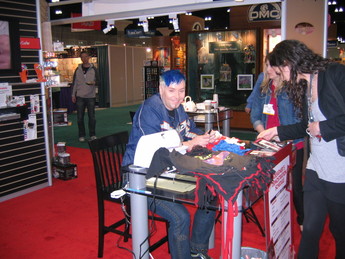 Oh, I also got to meet Suede, of Project Runway fame. He was hanging out at the Simplicity booth,talking about his new line of “Suede says” patterns he’s doing for them. Igrabbed one of the cute skirt patterns in the collection. Each pattern hasoptions for making the piece “flirty,” “edgy,” or “classic.” Suede said thathe’d be happy to do a Q&A with me, so look for that in the coming months!In the meantime, I’m going to try to figure out which description fits me. Ithink Suede needs a 4th category: “postpartum.”
When I came back from lunch on Saturday, I enteredthrough the door right next to the Kunin Group’s booth. I was immediately drawnto the amazing felt creations, like the pillows above. What was this stuff, I wondered? Must be wool felt, I thought. 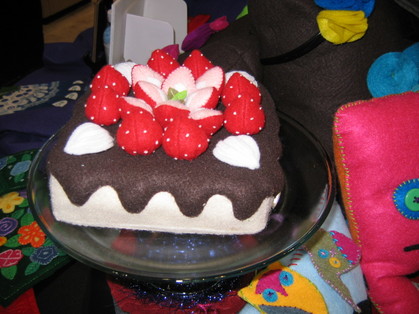 Wool felt? Think again. It's your oldest friend, polyester, but it's never looked better! It turns out, all of these lovely lovelies were madewith that basic craft felt that you find in Jo-Ann’s! I don’t know about you,but I’ve always sort of looked down on craft felt as cheap and polyester andsuitable mostly for kids’ art projects. But their display is definitely makingme take a second look. Plus, their Eco-Fi felt is nowmade from recycled plastic bottles. Yes, it’s still polyester, but they tookthe trouble to get UL certification, meaning that their products contain aminimum of 95 percent post-consumer recycled content. As George Stellmach, thenational sales and marketing manager told me, the bottles are just going to gointo a landfill—why not use them. Good point. 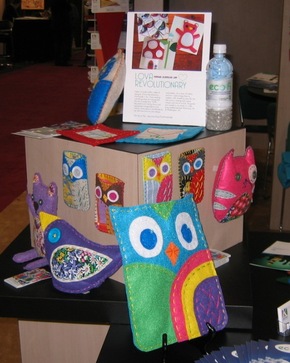 Wool felt is lovely—no one can deny that. And all thebetter if you are felting it yourself, using old wool sweaters. But thepolyester felt is a pretty good alternative, especially if you’re on a budget.
I think that about wraps up my CHA coverage. I'm still working on my post about why I've decided technology is a good thing, and I need to quit being such a scaredy-pants about it.
I’m still sifting through my notes and pictures, but I do have a few observations from the CHA show (which actually is still going on; I believe today is the last day).
So first, it dawned on me that crafting is a honkin’ big industry. I’ve reported on the industry, but haven’t really had the chance to witness the industry at work. I know it’s been hard hit (CHA veterans told me this year still looked small than years past, but better than last year). I’m so happy that people want to make things and want to spend tons of money doing it. Yes, it creates waste. Yes, it’s another form of consumerism. But nonetheless, I love to see that drive to create in action. 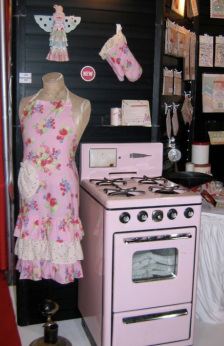 Secondly—and this is what I’m most excited about—retro is huge. HUGE. I’d like to think that I invented this trend. It’s my blog, so I can say that I did. But regardless of who got the ball rolling, it is rolling and rolling fast! I saw countless retro-themed booths, from yarn to scrapbooking. My absolute favorite display was this Melissa Frances booth.
I want this pink stove for my house! And the apron too!
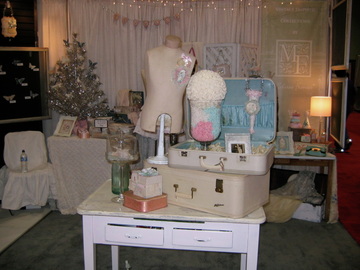 another Melissa Frances display I also liked the retro goods at October Afternoon (somehow I forgot to take a picture, but luckily, they’ve got images on their blog, here). A sales rep told me they were in the process of doing fabric, so that’s something to keep an eye on!
There were great booths from yarn manufacturers too. Red Heart Yarns was celebrating its 75th anniversary, and had a lovely birthday tent, complete with great retro ephemera, and a dress made from a retro pattern. Their knitted cakes were luscious, too. 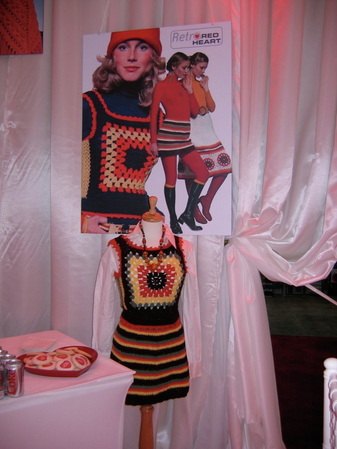 Inside the Red Heart birthday tent. I vaguely recall my sister having a look like this circa 1979. Love it! 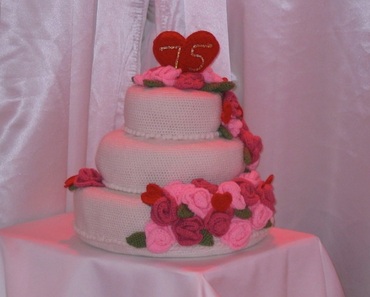 seriously, can I eat this? 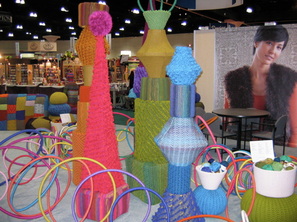 Lion Brand Yarn had an amazing display too, with beautiful graphic shapes wrapped in yarn, along with colorful furniture. I got the chance to talk to their creative director, and she talked about the new trend of yarn wrapping—using yarn as an art form. I’m pretty intrigued by this, even though I’m not much a knitter (though I did have a chance to brush up on my knitting skills, thanks to fellow Craftside author Elanor Lynn, who contributed to Modern Knits, Vintage Style, and was doing demos in the Craftside booth).The Caron booth provided some lovely fashionable eye candy as well.
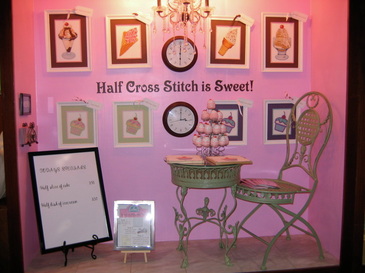 Ooh, and I loved the DMC sweet shop display! From fabric to yarn to felt to floss, companies have finally realized the awesome marketing potential of linking their product with something sweet. Even if we can’t actually eat the product, the visual is so strong that it draws us in. Pretty genius actually.
That’s all for now. I still want to write about my new-found love for cheap craft felt (yes, really) and my crush on keynote speaker Nick Bilton, and the many lightbulbs that went off in my head as he was speaking.
|




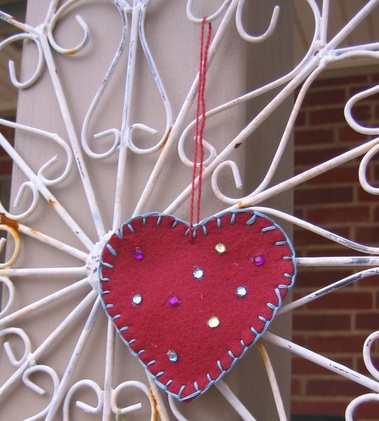
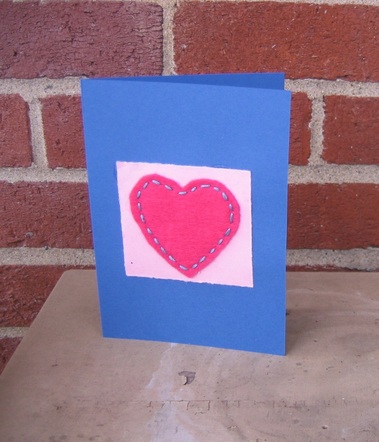
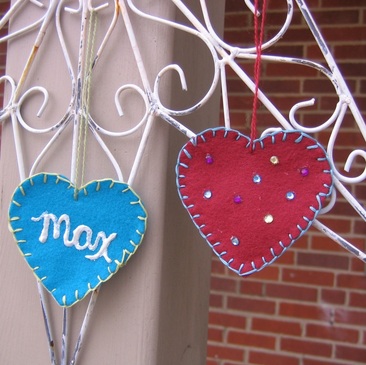
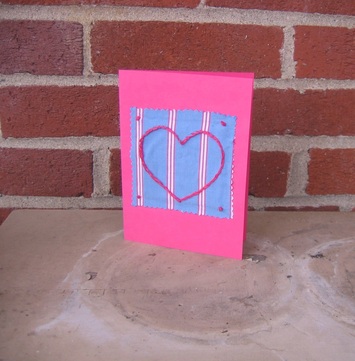
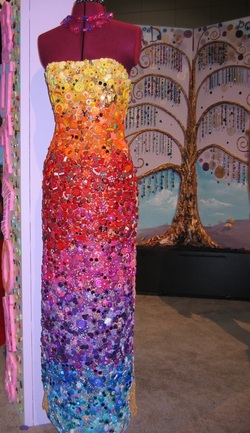
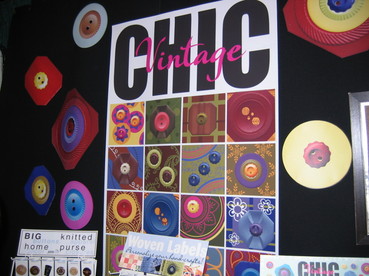

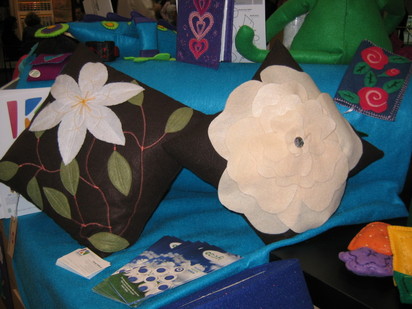

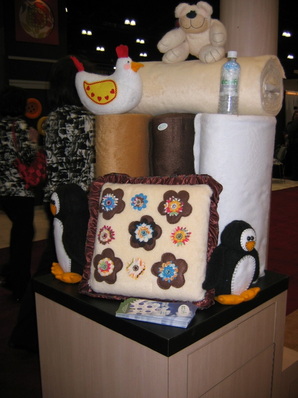



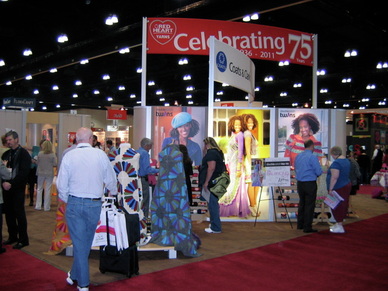



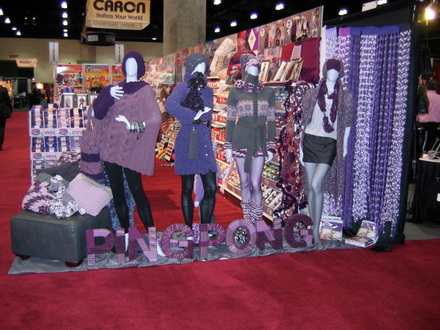

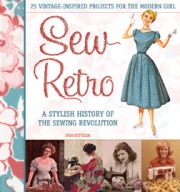

 RSS Feed
RSS Feed